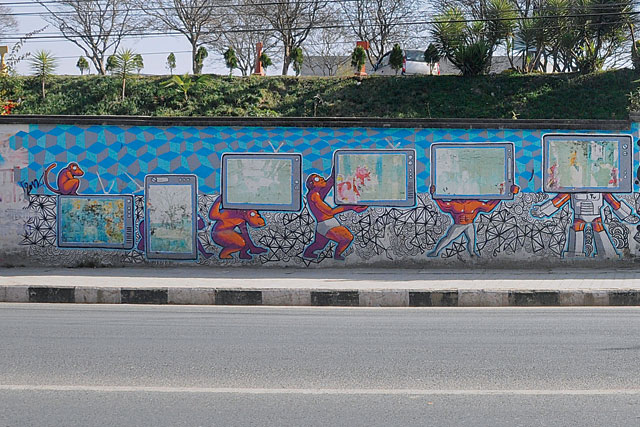One cannot walk the streets of Kathmandu these days without witnessing the work of a new generation of Nepali artists. Pushed by their peers and inspired by a rich historical background, they are delivering potent messages to society.
t isn’t a surprise that travellers overwhelmingly associate Nepal with snow-clad mountains. But once they hit the streets of Kathmandu, many are amazed by the emergence of a cultural movement. Graffiti on walls, a bunch of great live bands and prodigious multimedia exhibitions are signs that art is taking a hold over the capital.
The music scene has always been vibrant in the city. Still, musicians agree that education has brought a fresh approach and created a new buzz around arts in the past few years. Sanjay Shrestha, guitarist of Joint Family Internationale, a popular reggae band, believes that the Kathmandu Jazz Conservatory (KJC) has greatly inspired the musical culture of his group. In fact, his fellow band members themselves studied music there.
Visual arts are no exception. Since 2007, the Center of Arts and Design of Kathmandu University (KU Art+Design) has been offering a four-year bachelor program in Studio Art and Graphic Communication. Sadhu-X, creative head of the ArtLab collective and a KU alumni, recalls how students were encouraged to not only get inspired by the works of others, but also to try developing their own unique style. As a result, the new generation of artists have taken an open-minded approach, characterised by the fusion of contemporary and traditional techniques.

Around the time the first batches from KU Art+Design and KJC were graduating, a group of foreign-educated Nepalis were returning home. They were all motivated by the same objective - spurring a new cultural dynamic. The main focus of this community was sharing, and still is. As Kathmandu is a small place, artists who wanted to collaborate could meet with ease. This creative energy led to the foundation of several collectives in the span of five short years, all of whom have been working with both Nepalese and international artists. ArtLab, for example, is developing a long-term partnership with Pierre Gaudin and Eddy Vaudel from Menningar Chowk. The artists left France to embrace the “dynamic space of freedom” that Kathmandu had to offer. Above all, they felt that Nepali artists really enjoyed collaboration and the sharing of knowledge and ideas, an atmosphere that differed from the scene in their country.
Boundaries between art forms have indeed been blurred. Musicians, painters and photographers all agree that new technologies have favoured the union of artists. Moreover, recent advances in technology have allowed them to explore art spheres from around the world. Technology, it can be said, has also democratised the practice of arts. When photo.circle was created in 2007, it marked the beginning of digital photography in Nepal. “Suddenly, photography became more accessible,” recalls NayanTara Gurung Kakshapati, co-founder of the organisation. Artists, consequently, started using social platforms themselves to distribute their work.
When the contemporary artists of Kathmandu share techniques and resources, they also share the idea of constructing a progressive society. Art is used as a weapon of instruction, especially to develop critical thinking amongst the Nepalese.
Sadhu-X wants to stimulate the creativity of people through his work. “When pedestrians ask me what represent my murals, I tell them to think for themselves,” he says. The artist chose to practice street arts to change the long-standing perception of art being a luxury good. Romel Bhattarai, manager of ArtLab, agrees that murals have the potential to ignite positive changes. “The artworks and ideas aren’t compressed in galleries, but directly in the eye of the beholder.”
In the same way, Lisa Neubert from the media arts collective Sattya, says that besides the idea of bringing Nepali and international artists together, their project Kolor Kathmandu aimed to deliver messages that would encourage the citizens of Kathmandu to think critically about social issues.
For the past five years, ArtLab, Sattya and photo.circle have made Kathmandu a brighter place, paving the way for a generation of artists who needed to witness the potential of art in their country. In order to achieve this, they not only depend on grants and donations but also sell services to continue with their creative work, shows and exhibitions.
There is so much more to Nepal than trekking. If things continue in a similar manner, there’s absolutely no doubt that Kathmandu will soon become a vibrant art capital.










